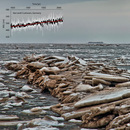Human influence on sea level rise: natural variability stronger than previously thought
The role of natural variations in the rate of sea level rise over the past century is larger than previously recognized, says a study led by German scientists from the University of Siegen.
Global sea levels have been rising by 14-21 cm since 1900 significantly threatening coastal communities along the world’s coastlines. Most of this rise has been attributed to human- greenhouse gas emissions. A new study, led by the German scientist Sönke Dangendorf and published today in the journal Nature Communications, now suggests that the role of natural variations has been significantly underestimated. “So far the great majority of the observed sea level rise has been attributed to human influences”, says Sönke Dangendorf from the Research Institute for Water and Environment (fwu) led by Jürgen Jensen at the University of Siegen. “The previously published uncertainties of global and regional sea level rise since 1900 were usually not larger than 2-3 cm meaning that roughly 90 % were attributed to human causes. These numbers were based on the assumption that natural variations do not persist for longer than a few years. Our results now suggest that natural variations in sea level can persist for decades or even centuries. Consequently, we cannot rule out that they could account for up to ±8 cm of the observed rise since 1900.”
According to the Fifth Assessment Report of the Intergovernmental Panel on Climate Change (IPPC) ocean warming and melting glaciers together account for roughly 80 % of the observed rise in global mean sea level since 1900, while the contribution of the large ice-sheets in Greenland and Antarctica still remains uncertain. “However, it is also clear that the long-term trends observed in both components are not purely anthropogenic”, says co-author Marta Marcos from the Mediterranean Institute for Advanced Studies (IMEDEA) at Mallorca, Spain. “From earlier studies we know, for instance, that glaciers have been melting also as a delayed response to the Little Ice Age ending in the 19th century. Independent assessments of the glacier contribution reveal that only 50 % of this melting can be attributed to human influences. The human contribution to ocean warming is well known only for the past decades, for which it reached 90% of the total warming, but it is unlikely that this contribution exceeds 50-60 % over the entire 20th century since the greenhouse gas emissions have been accelerating significantly throughout the century.”

Tide gauges, which measure sea level at the coast, are the main source of information about past sea level change. However, tide gauges do not only measure ocean warming and ice melt changes, but also regional variations forced by winds. Indeed these winds dominate the signal observed at the coast. Alfred Müller, also co-author of the study and based at the University of Siegen as well, argues: “The signal of winds masks any long-term signal on regional scales, not only human induced, but also other natural variations. This has previously led to overconfidence in estimating the influence of human-induced climate change on regional sea level.” By decomposing the observed sea-level variations into their individual contributions the scientists could better describe the natural variations in sea level. “Our new assessment suggests that even with improved estimates of the lower bound of the human contribution to the entire global mean sea level rise was at least 45 % in the past century. This number is smaller than earlier estimates but in good agreement with numbers from studies of the individual components”, Sönke Dangendorf concludes.
However, while the study finds that the role of natural variations has been underestimated before, it also shows that even with more conservative estimates there is an unambiguous footprint of human activities in sea level rise. “Any further increase of sea level rise will confront us with an enhanced risk of coastal flooding. Therefore, we need to adapt against a further future increase as soon as possible”, Jürgen Jensen says.
Photo: Dr. Sönke Dangendorf
Reference:
Dangendorf, S., Marcos, M., Müller, A., Zorita, E., Riva, R.E.M., Berk, K., Jensen, J. (2015): Detecting anthropogenic footprints in sea level rise, Nature Communications, doi:10.1038/ncomms8849.


